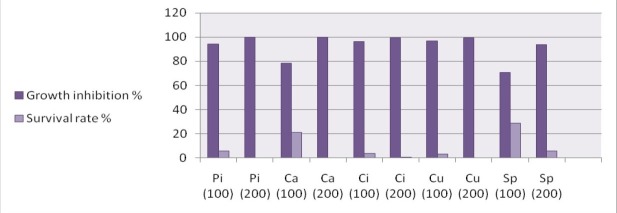Abstract
Toxoplasmosis drugs have the longest history and are still the first choice for most conditions. Alternative drugs such as Co-trimoxazole and Tetracycline have been tried and acclaimed successful. The lack of general acceptance, however, is an indication that the results are not very convincing. A wide range of antibiotics is urgently needed for patients with drug reaction or resistance problems. The anti-toxoplasmic activity of water and ethanol extracts as well as the oil of some home spices (Piper nigrum, Capsicum frutescens, Cinnamomum cassia and Curcuma longa), were evaluated in murine models of intraperitoneal infection using the RH strain of Toxoplasma gondii. Female mice were infected with 2×102 tachyzoites/ml, and then treated intraperitoneally with the home spices at 100 and 200 mg/kg/day for seven days. The tested extracts reduced the mean number of tachyzoites present in the peritoneal fluid of the experimental mice. The most effective extract was Curcuma longa ethanol extract which showed a 98.6% and 99.2% inhibition of the growth of Toxoplasma tachyzoites in 100 and 200 doses respectively compared to the control infected untreated mice.
Keywords: Anti-toxoplasmic activity, Home spices, Piper nigrum, Capsicum frutescens, Cinnamomum cassia, Curcuma longa, Toxoplasma gondii, RH strain
INTRODUCTION
The protozoan Toxoplasma gondii has a world-wide distribution. It is an obligate intracellular parasite that appears in many species of mammals and birds.1
The life cycle of T. gondii is unusual, in that the organism is capable of indefinite replication using either sexual or asexual subcycles. The asexual portion of the life cycle consists of just two stages: the rapidly dividing tachyzoites,and the more slowly dividing bradyzoites, which can be encysted in the brain, heart and other tissues.2
To control toxoplasmosis, a combination of antifolates, such as pyrimethamine and sulfadiazine, have been used with success and they are the first choice drugs in most clinical settings.3,4 However, numerous undesirable side effects such as haematological toxicity (caused by pyrimethamine), cutaneous rash, leukopenia and thrombocytopenia (caused by sulphonamides) are often reported.4–7
The antitoxoplasmic activity of Spiramycin was evaluated in murine models of infection using a type-1 (RH) or type-2 (Me49) strain of T. gondii. In mice infected with 102 tachyzoites of the RH strain, treatment with 100 and 200 mg SPI/kg/day had only a limited effect. Despite some dose-dependent prolongation of survival, it was unable to protect mice from death.8
The anti-toxoplasmic activity of Spiramycin and Myrrh were evaluated in murine models of intraperitoneal infection using the RH strain of T. gondii in mice infected with 2×102 tachyzoites/ml, and with 1×104 tachyzoites/ml, treatment with those drugs at 100 and 200 mg/kg/day had a good effect.9,10
Juniperus procera water extracts were evaluated for their antitoxoplasmic activity, compared with Spiramycin using an intraperitoneal infection by the RH strain of T. gondii. The fruit of J. procera as well as Spiramycin recorded good results with a percentage of 53.5 and 98.5 % respectively growth inhibition for T. tachyzoites. Leaves of the tested plant inhibited 50 % of tachyzoites growth, while inhibition by stems was 48 % compared with the tachyzoites mean number in control untreated mice.11
Alcohol extracts of the herbs Sophora flavescens, Sinomenium acutum, Pulsatilla koreana, Ulmus macrocarpa and Torilis japonica were studied In vitro as anti-protozoal activity against cultures of T. gondii and Neospora caninum. These extracts were serially diluted to final concentrations ranging from 625 to 19.5 ng/ml in media and added to wells containing either T. gondii or N. caninum tachyzoites in equine dermal cells. The inhibition of the growth of parasite was measured using 3H-uracil incorporation as compared to untreated controls. Torilis japonica inhibited T. gondii proliferation by 99.3, 95.5, 73.0 and 54.0% in the range from 156 to 19.5 ng/ml, and Sophora flavescens inhibited T. gondii proliferation by 98.7, 83.0 and 27.2% in the range from 156 to 39 ng/ml.12
In an effort to improve the therapies used against T. gondii RH strain, numerous home spices with high activity were examined. In this study, the results of the preliminary screening of aqueous and ethanol extracts as well as the oils of four home spices were recorded for their anti-T. gondii tachyzoites activity.
MATERIAL AND METHODS
Experimental mice
Six-week-old female Swiss albino mice, weighing 18-20 grams at the beginning of the study (obtained from Experimental Animal Unit of Medical Research Center, Faculty of Medicine, Ain Shams University, Cairo, Egypt) were used. The mice were housed three per cage, given drinking water and regular mouse food, ad libitum. These animals were kept for at least one week to get them acclimatized to the conditions before being subjected to any experimentation.
Parasites under study
The RH strains of T. gondii were maintained by routine intraperitoneal passage every 72 hours after they were obtained from the Medical Research Centre/Ain Shams University. The tachyzoites concentration was determined by means of a haemocytometer. It was re-suspended at a density of 2×102/ml in saline and 0.2–0.9 ml aliquots to be inoculated intraperitoneally into the female mice.8,13,14
Preparation of home spices extracts
The four dried home spices were weighed and homogenized separately using an electric blender. The crushed materials were stored in screw-top glass bottles at room temperature in the dark. To make the extracts, cold distilled water and absolute ethyl alcohol were used employing the following procedure. Known weights of dry crushed home spices were put in two separate beakers of 1000ml. Different solvents were separately added to the fine particles of the powder of the home spices, covered with aluminum foil and kept in the dark at room temperature. The extraction time was standardized at 24 hours. The mixtures were passed through a Buchner funnel and a layer of cotton using a vacuum pump. The particles were then washed exhaustively with the solvent used. The extracts were concentrated under vacuum at 100°C and 60°C for distilled water and absolute ethyl alcohol respectively using the rotary evaporator, and were weighed in pre-weighed beakers.15
Regarding the plant extract weight, two concentrations of 1:1 and 2:1 were prepared using specific sterile water for injection (Egypt Otsuka Pharm. Co.). Different dilutions were administered at doses of 100 and 200 mg/kg/body weight. Oils of these home spices were used at doses of 0.1 and 0.2 ml.8
Reference Drug
Spiramycin (Rovamycin® 500, Rhone-poulenc Rorer Aebe) was used as a reference drug and administered at doses of 100 and 200 mg/kg/body weight. It was crushed and dissolved in water specific for injection at the same concentrations (1:1 and 2:1) according to the drug weight.
Testing for anti-Toxoplasma activity
Groups of experimental female mice were examined for the activity of the home spices, as aqueous, ethanol extracts and their oils for T. gondii tachyzoites.
Home spices groups
Twenty-four female mice (n = 3 for each dose) were injected intraperitoneally with 2×102 tachyzoites of T. gondii RH strain and assigned to treatment with 100 and 200 mg of aqueous extracts, ethanol extracts and 0.1 and 0.2 ml of spice oils. Treatment was initiated 24 hours post infection and continued for seven days.8 On the eighth day, the peritoneal fluids of the dead mice were examined, the number of tachyzoites was counted with a hemocytometer and compared with the infected control groups .
Control groups
Four groups were used as control groups (n = 3 female mice for each dose), Spiramycin treated group, injected with the same dose of T. tachyzoites and treated with 100 and 200 mg of Spiramycin on the eighth day post infection, water solvent treated group injected by 0.1 and 0.2 of water suitable for injection after seven days of infection, infected control untreated group and normal control group.
Statistical analysis
The results of the experiment were analyzed by using a two-way analysis of variance (ANOVA). Least significant differences (LSD) were used as Post Hoc Test at a statistically significant level of 0.05 to perform pair-wise comparisons following significant ANOVA tests.
RESULTS
Aqueous extracts activity
The effect of the two doses (100 and 200 mg/kg/day) of the aqueous spice extracts in the reduction of the number of T. gondii tachyzoites was recorded (Table 1). In 100 mg/kg/day, the growth inhibition ranged from 81.2% in Piper nigrum with the mean of tachyzoites as 10866.7 ± 10104.1 to 97.4% in Curcuma longa with the mean of tachyzoites as 1500 ± 2511.9 compared with the growth inhibition resulting from the use of Spiramycin as 71% with the mean of the number of tachyzoites as 16733.3 ± 18941.3.
Table 1.
Reduction of tachyzoites of Toxoplasma gondii in peritoneal fluid of female mice (n=3/dose) treated with aqueous extract of some home spices and Spiramycin drug after initial infection by 2×102 tachyzoites/ml/mice
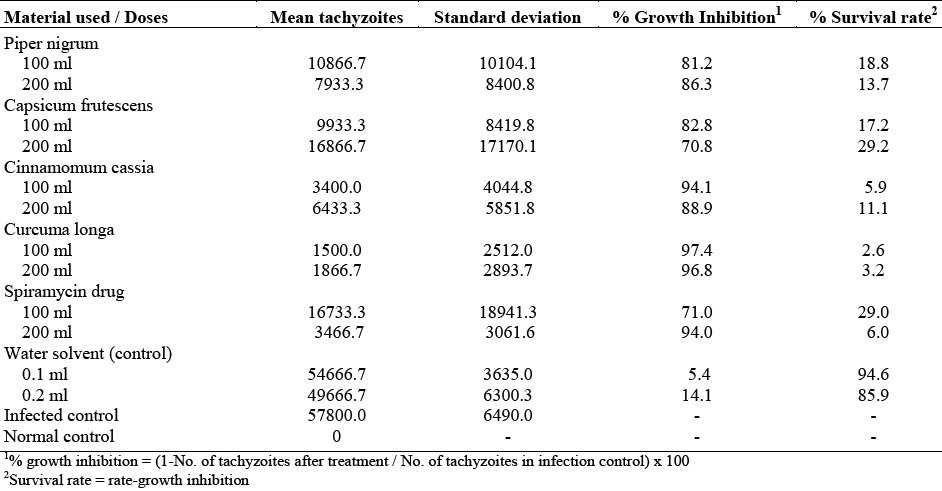
The survival rate (Figure 1) for the T. tachyzoites in 200 mg/kg/day ranged from 29.2% in Capsicum frutescens (mean tachyzoites number = 16866.7 ± 17170.1) to 3.2% in Curcuma longa (mean tachyzoites number = 1866.7 ± 2893.6) compared with Spiramycin which gave a survival rate of 6% (mean tachyzoites number = 3466.7 ± 3061.5).
Figure 1.
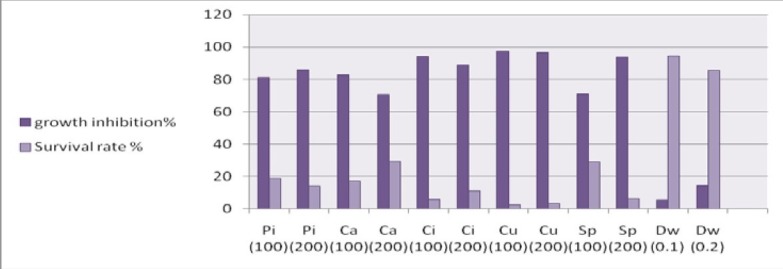
Growth inhibition and survival rate of some spices aqueous extracts
(Pi=Piper nigrum, Ca=Capsicum frutescens, Ci=Cinnamomum cassia, Cu=Curcuma longa, Sp=Spiramycin drug, Dw=Dissolving water)
There was no significant difference between the doses of the aqueous extract used (p= 0.55), on the basis of the tachyzoites number. There were significant differences between all tested aqueous extracts as well as Spiramycin and the infected untreated control (p= 0.00) also with those mice given only the water solvent (p= 0.00), while the infected control mice did not significantly differ from those injected only with the water (p= 0.38). The effect of the Curcuma longa water extract was significantly different from that of red chili pepper (p= 0.034) at the 0.05 level.
Ethanol extracts activity
The reduction of the number of tachyzoites of T. gondii resulting from the use of ethanol extracts of some home spices was calculated (Table 2). In Curcuma longa, the maximum growth inhibition was 98.6% and 99.2% with mean of tachyzoites number as 800 ± 1385.6 and 466.7 ± 808.2 in the two respective doses. In comparison with Spiramycin, the survival rate was 29% (mean number of tachyzoites = 16733.3 ± 18941.3) and 6% (mean tachyzoites number = 3466.7 ± 3061.5) for the two doses used (Figure 2).
Table 2.
Reduction of tachyzoites of Toxoplasma gondii in peritoneal fluid of female mice (n=3/dose) treated with some home spices ethanol extract and Spiramycin drug after initial infection by 2×102 tachyzoites/ml/mice
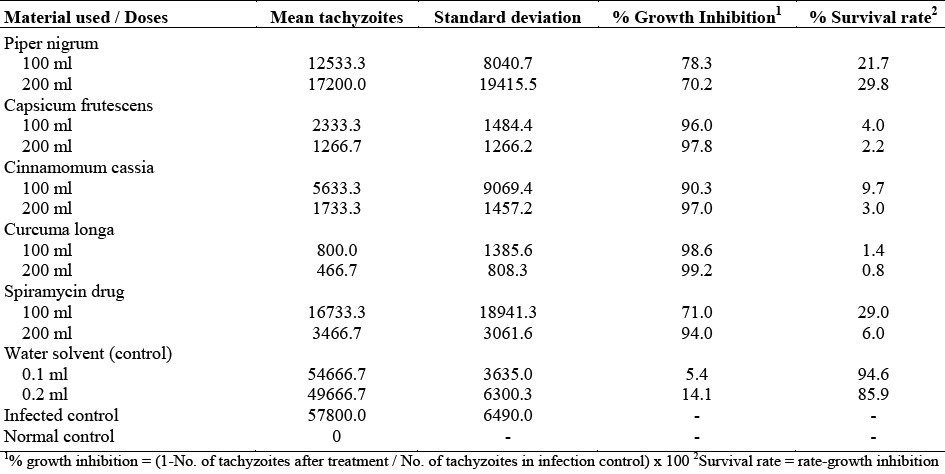
Figure 2.
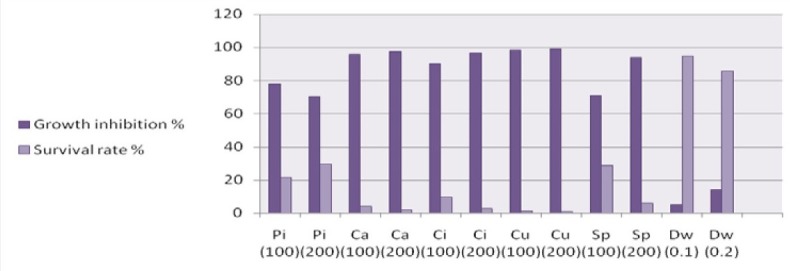
Growth inhibition and survival rate of some home spices ethanol extracts
(Pi=Piper nigrum, Ca=Capsicum frutescens, Ci=Cinnamomum cassia, Cu=Curcuma longa, Sp=Spiramycin drug, Dw=Dissolving water)
There was no significant difference between the doses of ethanol extract used in the treatment of T. gondii tachyzoites (p= 0.29). The result of the four home spices and Spiramycin differred significantly from that of the water solution or that of infected control (p= 0.00). Black pepper extract also differed significantly from the ethanol Curcuma extract (p= 0.009) at the level of 0.05.
Spice oil activity
The effect of the home spice oil used to reduce the number of tachyzoites of T. gondii in the peritoneal fluid of the female mice is mentioned (Table 3). Within seven days of treatment, almost all the mice had died, but the dissection and examination of their peritoneal fluid showed little or no tachyzoites with oily traces in their abdominal cavity (Figure 3).
Table 3.
Reduction of tachyzoites of Toxoplasma gondii in peritoneal fluid of female mice (n=3/dose) treated with aqueous extract of some home spices oils and Spiramycin drug after initial infection by 2×102 tachyzoites/ml/mice
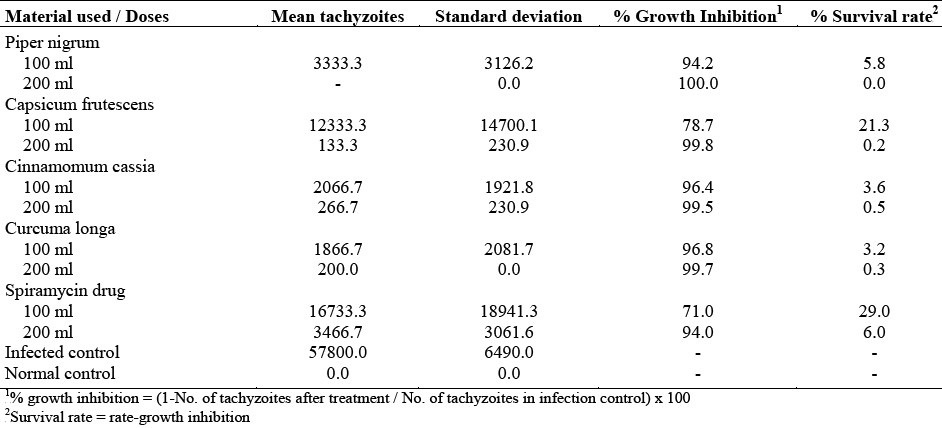
Figure 3.
Growth inhibition and survival rate of some home spices oil
(Pi=Piper nigrum, Ca=Capsicum frutescens, Ci=Cinnamomum cassia, Cu=Curcuma longa, Sp=Spiramycin drug, Dw=Dissolving water)
The doses of home spice oil used were significantly different (p= 0.04). All the results of the spice oils as well as those of Spiramycin differ significantly from that of water solvent and that of the infected control untreated mice (p= 0.00) at the 0.05 level.
DISCUSSION
The presented results show the activity of home spice extracts and Spiramycin in murine infection with RH strain of T. gondii. In the infection induced with 2×102 tachyzoites/ml, Spiramycin showed an obvious effect, and was able to protect mice from death.
The action of Spiramycin at either 100 or 200 mg/kg/day for one week did not protect any mice from death by toxoplasmosis, as recorded by various T. gondii tachyzoites seen in the mice peritoneal fluids.8 This differed from the results presented here, which showed a growth inhibition of T. gondii tachyzoites as 71% and 94% on treatment with Spiramycin in 100 or 200 mg/kg/day for seven days respectively. Also this result is quite comparable to that recorded by Al-Zanbagi N,10 who found that this drug inhibited the T. tachyzoites growth at 91% and 96% at the same doses used. But when Spiramycin was administered at higher doses, the inhibition of growth was better, as recorded by Al-Zanbagi N,11 whose percentage of growth inhibition was 98% in 400 mg/kg/day for seven days post infection.
Curcuma longa water extracts were evaluated for their antitoxoplasmic activity compared with other aqueous extracts of home spices using an intraperitoneal infection by the RH strain of T. gondii. It showed the best results as 97.4 and 96.8% in doses of 100 or 200 mg/kg/day respectively for a one-week treatment period. This aqueous extract showed better results than what was recorded for Juniperus procera studied by,11 who found that fruit, leaves and stems of this plant inhibited the growth of parasites as 53.5%, 50 % and 48 % in a dose of 400 mg/kg/day. The aqueous extract of Curcuma longa showed less activity than what was found when a water extract of m yrrh was used as an anti-toxoplasmosis agent with the growth inhibition as 96.6%, 100 % in doses of 100 and 200 mg/kg/day respectively after four days of treatment of experimental mice infected with 2×102 tachyzoites/ml.9 In comparing the results of Curcuma longa water extracts with that obtained by,10 who tested the mice infected with 1×104 tachyzoites/ml and then treated intraperitoneally with Myrrh water extract at 100 and 200 mg/kg/day, the growth inhibition was 97% and 98% after four consecutive days of treatment which is similar to that recorded for Curcuma longa when tested for seven days as a drug for toxoplasmosis.
The maximum survival rate for T. gondii tachyzoites was 21.7% and 29.8% in doses 100 and 200 mg/kg/day by using ethanol extract of Piper nigrum respectively. Using the Curcuma longa ethanol extract, the survival rate was 1.4% and 0.8% in the two doses used respectively, which means the inhibition of growth was better at 98.6% and 99.2%. Similar results of inhibition of growth (99.3% and 98.7%) in vitro for the T. gondii proliferation were recorded when the alcohol extract of Torilis japonica and Sophora flavescens at 156 ng/ml in media added to wells containing T. gondii were used.12
The results of the oils of all home spices were considerable. Piper nigrum was more active as a growth inhibitor for T. gondii tachyzoites giving the percentage of 94.2% and 100% in the doses of 100 and 200 mg/kg/day, compared with that of Curcuma longa. The proliferation of the tested parasites was inhibited at 98.6% and 99.2% in the same doses used.
In conclusion, results of all the tested home spices from black pepper to the rhizome of curcuma using water or ethanol extraction solvents as growth inhibitors for the parasite, T. gondii were encouraging. To improve the activity of the tested extracts as anti-toxoplasmosis, another experimental design should be used in which the experimental mice are given the extracts orally instead of intraperitoneal injection.
REFERENCES
- 1.Reikvam Å, Lorentzen-styr A. Virulence of different strains of Toxoplasma gondii and host response in mice. Nature. 1976;261:508–9. doi: 10.1038/261508a0. [DOI] [PubMed] [Google Scholar]
- 2.Boothroyd JC, Grigg ME. Population biology of Toxoplasma gondii and its relevance to human infection: do different strains cause different disease? Current Opinion in Microbiology. 2002;5(4):438–42. doi: 10.1016/s1369-5274(02)00349-1. [DOI] [PubMed] [Google Scholar]
- 3.Harris C, Salgo MP, Tanowitz HB, Wittner M. In vitro assessment of antimicrobial agents against Toxoplasma gondii. J Infect Dis. 1988;1570:14–22. doi: 10.1093/infdis/157.1.14. [DOI] [PubMed] [Google Scholar]
- 4.Dantas-Leitz L, Urbina JA, de Souza W, Vommaro RC. Anti-proliferative synergism of azasterols and antifolates against Toxoplasma gondii. Int J Antimicrob Agents. 2005;25:130–5. doi: 10.1016/j.ijantimicag.2004.08.016. [DOI] [PubMed] [Google Scholar]
- 5.Derouin F, Chastang C. In vitro effects of folate inhibitors on Toxoplasma gondii. Antimicrob Agents Chemother. 1989;33:1753–9. doi: 10.1128/aac.33.10.1753. [DOI] [PMC free article] [PubMed] [Google Scholar]
- 6.Alder J, Hutch T, Meulbroek JA, Clement JC. Treatment of experimental Toxoplasma gondii infection by clarithromycin-based combination therapy with minocycline or pyrimethamine. J Acquir Immune Defic Syndr. 1994;7:1141–8. [PubMed] [Google Scholar]
- 7.Choi K, Gang J, Yun J. Anti-Toxoplasma gondii RH strain activity of herbal extracts used in traditional medicine. International Journal of Antimicrobial Agents. 2008;32(4):360–2. doi: 10.1016/j.ijantimicag.2008.04.012. [DOI] [PubMed] [Google Scholar]
- 8.Grujić J, Djurković-Djaković O, Nikolić A, Klun I, Bobić B. Effectiveness of spiramycin in murine models of acute and chronic toxoplasmosis. International Journal of Antimicrobial Agents. 2005;25(3):226–30. doi: 10.1016/j.ijantimicag.2004.09.015. [DOI] [PubMed] [Google Scholar]
- 9.Al-Zanbagi NA. Effectiveness of Myrrh and Spiramycin as Inhibitors for Toxoplasma gondii Tachyzoites In Vivo. Mansoura Journal of Forensic Medicine and Clinical Toxicology. 2007;15(2):117–28. [Google Scholar]
- 10.Al-Zanbagi NA. Comparative study of Myrrh Extract and Spiramycin Drug as growth Inhibitors of Toxoplasma gondii Tachyzoites In Vivo. Egyptian Journal of Zoology. 2008a;50:159–68. [Google Scholar]
- 11.Al-Zanbagi NA. Noticeable effect of Juniperus procera as Toxoplasma gondii Tachyzoites Inhibitor In Vivo. The 5th Congress of Scientific Research Outlook in the Arab World. 2008b (Under press) [Google Scholar]
- 12.Youn HJ, Lakritz J, Kim DY, Rottinghaus GE, Marsh AE. Anti-protozoal efficacy of medicinal herb extracts against Toxoplasma gondii and Neospora caninum. Veterinary Parasitology. 2003;116(1):7–14. doi: 10.1016/s0304-4017(03)00154-7. [DOI] [PubMed] [Google Scholar]
- 13.Piketty C, Derouin F, Rouveix B, Pocidalo J. In Vivo assessment of antimicrobial agents against Toxoplasma gondii by quantification of parasites in the blood, lung and brain of infected mice. Antimicrobial Agents and Chemotherapy. 1990;34(3):1467–72. doi: 10.1128/aac.34.8.1467. [DOI] [PMC free article] [PubMed] [Google Scholar]
- 14.Nikolić T, Djurković-Djaković O, Bobić B, Nikolić A, Babić D. Treatment protocol determines the efficacy of clindamycin in acute murine toxoplasmosis. International Journal of Antimicrobial Agents. 1999;11:145–9. doi: 10.1016/s0924-8579(98)00064-8. [DOI] [PubMed] [Google Scholar]
- 15.Al-Zanbagi NA. PhD Thesis. Aberystwyth: University of Wales; 1999. Plant molluscicides from Saudi Arabia Euphorbiales for use against the snail intermediate hosts of schistosomes. [Google Scholar]



